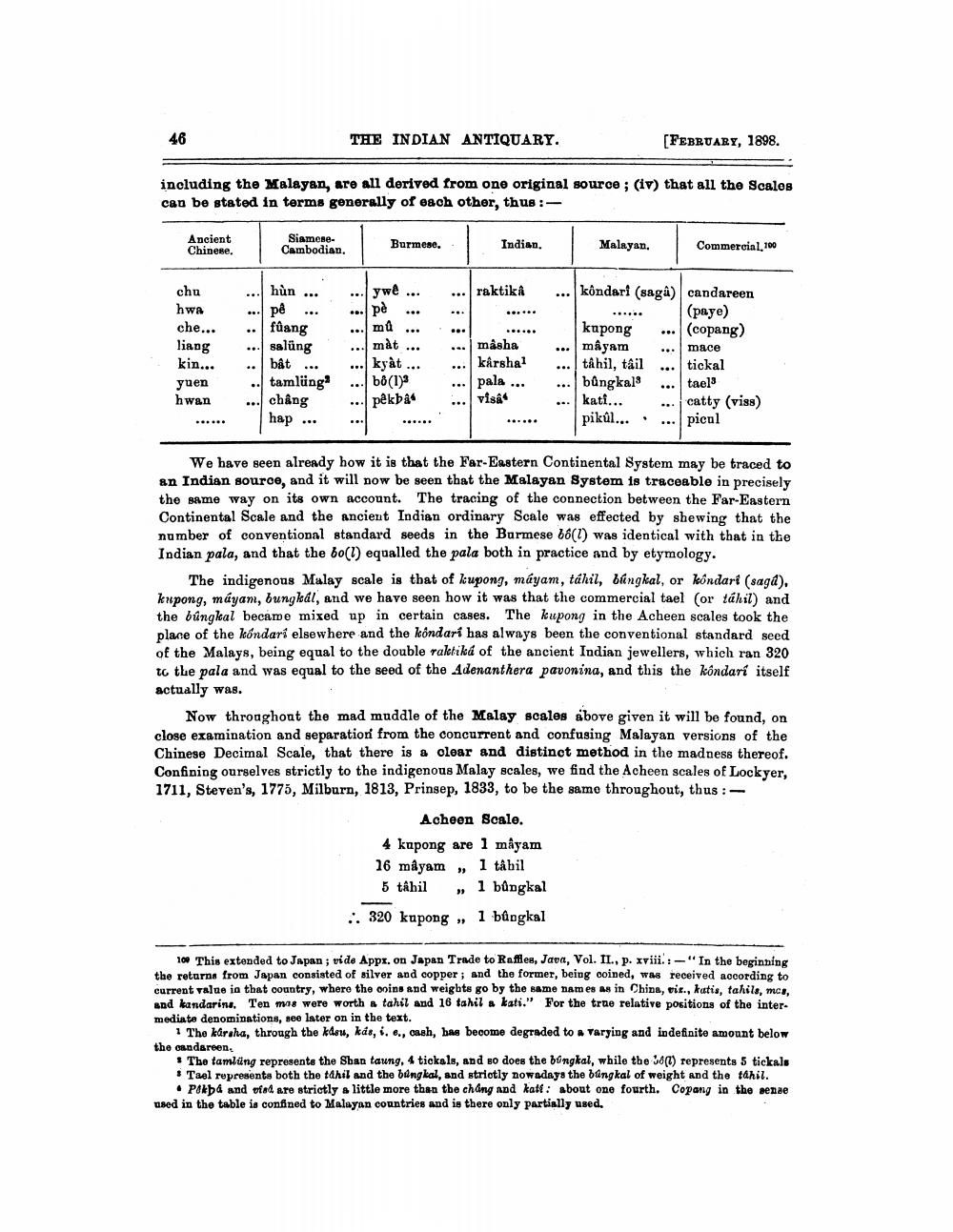________________
46
THE INDIAN ANTIQUARY.
[FEBRUARY, 1898.
including the Malayan, are all derived from one original source ; (iv) that all the Scalos can be stated in terms generally of each other, thus:
Ancient Chinese.
SiameseCambodian.
Burmese.
Indian.
Malayan.
Commercial.100
hùn .
raktiká
chu hwa che...
pê ... fũang salung
.
liang kin...
masha karshal
bât ...
... kondari (sagû) candareen
(paye) kupong (copang) mayam
mace tâhil, tail ... tickal bungkal ... tael kati...
catty (viss) pikúl.......
picul
kyat ... b8(1)3 pêkba
yuen hwan
pala ...
tamling châng hap...
visa
We have seen already how it is that the Far Eastern Continental System may be traced to an Indian source, and it will now be seen that the Malayan System is traceable in precisely the same way on its own account. The tracing of the connection between the Far Eastern Continental Scale and the ancient Indian ordinary Scale was effected by shewing that the number of conventional standard seeds in the Burmese 66(1) was identical with that in the Indian pala, and that the bo(1) equalled the pala both in practice and by etymology.
The indigenous Malay scale is that of kupong, máyam, táhil, bingkal, or kondari (sagd), kupong, máyam, bungkal, and we have seen how it was that the commercial tael (or táhil) and the búngkal became mixed up in certain cases. The kupong in the Acheen scales took the place of the kõndari elsewhere and the köndari has always been the conventional standard seed of the Malays, being equal to the double raktiká of the ancient Indian jewellers, which ran 320 to the pala and was equal to the seed of the Adenanthera pavonina, and this the kôndari itself actually was.
Now throughout the mad muddle of the Malay scales above given it will be found, on close examination and separation from the concurrent and confusing Malayan versions of the Chinese Decimal Scale, that there is a clear and distinct method in the madness thereof. Confining ourselves strictly to the indigenous Malay scales, we find the Acheen scales of Lockyer, 1711, Steven's, 1775, Milburn, 1813, Prinsep, 1833, to be the same throughout, thus :
Acheen Scale. 4 kupong are 1 mayam 16 mâyam , 1 tábil
5 tâhil » 1 bùngkal :. 320 kupong , 1 bûngkal
100 This extended to Japan ; vide Appx, on Japan Trade to Raffiles, Java, Vol. II., P. xviii. :-"In the beginning the returns from Japan consisted of silver and copper; and the former, being coined, was received according to current value in that country, where the onins and weights go by the same names as in China, vit., katis, tahils, mca, and kandarins. Ten mas were worth a tahil and 16 tahil a kati." For the true relative positions of the intermediate denominations, see later on in the text.
The kürsha, through the kdeu, kas, i, e., cash, has become degraded to a varying and indefinite amount below the gandareen.
The tamlúng represents the Sban taung. 4 tickals, and so does the bungkal, while the 38) represents 5 tickals * Tael represents both the tail and the bingkal, and strictly nowadays the bungkal of weight and the táhil.
• Pokha and vial are strictly a little more than the chang and katt: about one fourth. Copang in the sense used in the table is confined to Malayan countries and is there only partially used.




